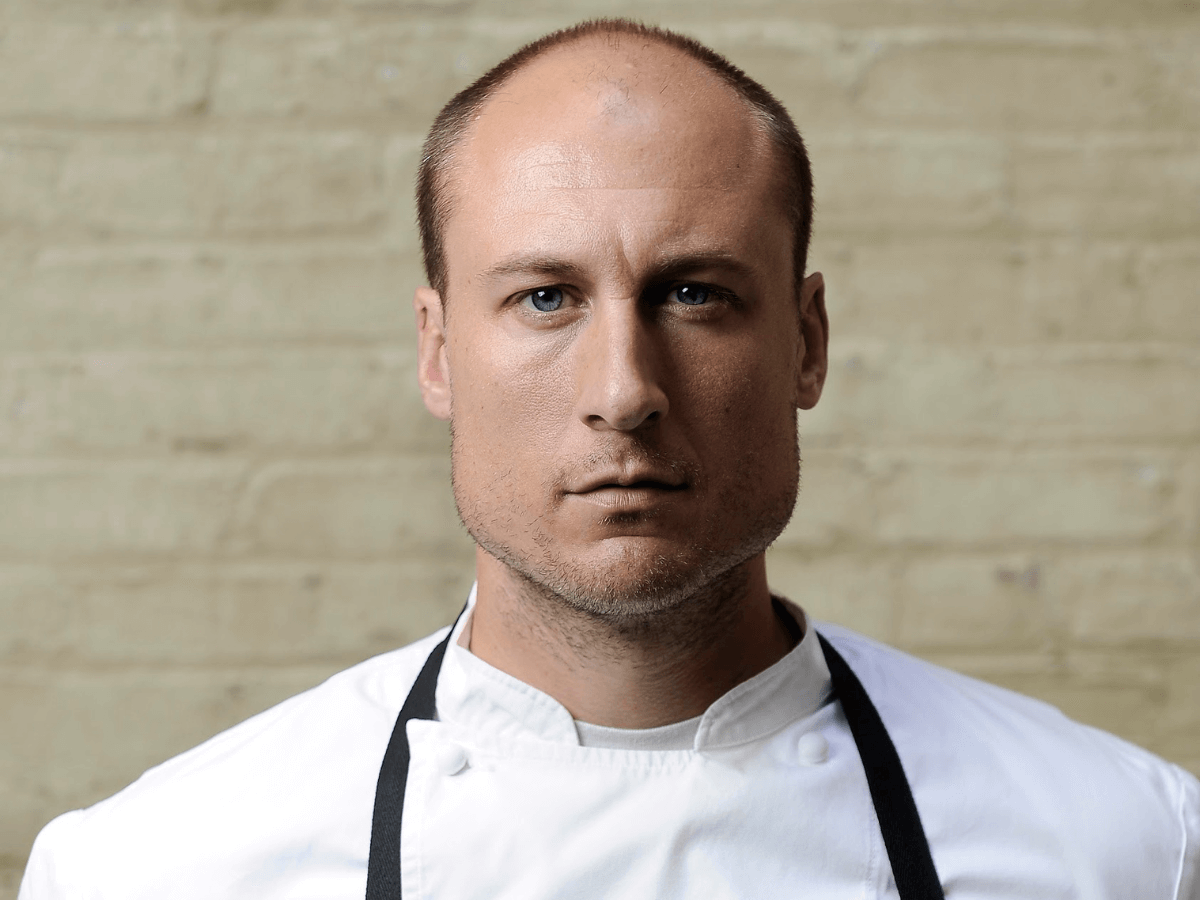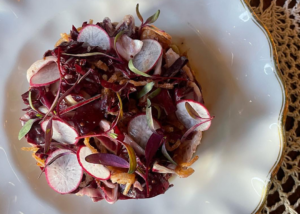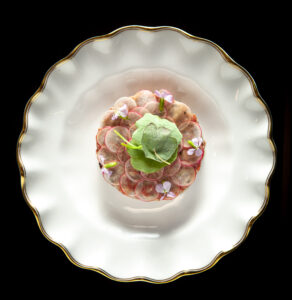

Dave Beran hails from upstate New York and became instrumental in advancing Chicago’s cutting-edge dining scene. He worked at MK and Tru before joining chef Grant Achatz, business partner Nick Kokonas and their team at avant-garde Alinea. Beran advanced to the Chef de Cuisine post during his tenure. In 2011, he became Executive Chef at sister restaurant NEXT, an ambitious restaurant that changes their menu, dining experience and culinary focus a few times per year. 2014 was a particularly memorable year for Beran, who won the James Beard Award for Best Chef: Great Lakes and became a Food & Wine Best New Chef.

Dry Aged Beef Tartare
In 2017, Beran relocated to Los Angeles to open Dialogue, an 18-seat tasting menu restaurant tucked away on Santa Monica’s Third Street Promenade. Dialogue earned great acclaim. GQ magazine named Dialogue among Best New Restaurants in America that year. They also earned one Michelin star in 2019. He currently runs an “elevated French bistro” called Pasjoli in Santa Monica that “pays homage to French cuisine utilizing the bounty of produce available in Southern California.” Pasjoli recently introduced their dégustation, a 10-12 course tasting menu that builds on the type of interactive culinary experience that made Dialogue such a destination.
Learn about Beran’s connection to Flannery Beef and get his thoughtful takes on steak.
How did you discover Flannery Beef?
When I was in Chicago, at NEXT, we were going to do a steakhouse menu. In our typical fashion, we did this whole, “Let’s find the best steak in the country for the steakhouse.” Our R&D Assistant basically went on this mission to get beef from everywhere and anywhere he could get his hands on. So we tried everything, from local purveyors like Allen Brothers, who were down the street from us, to Snake River, Omaha Steaks and Flannery Beef. We basically did a March Madness style bracket of beef, all blind tastings, and Flannery won.
We reached out to them and said, “Hey, we want to use your beef. And we want to do 60-day dry aged, and we’re gonna go through something stupid – like 30 ribeyes a week,” and they were like, “You want to do what?” So we did it and started working with them. One of the first deliveries was in winter in Chicago, and the delivery wasn’t going to make it to us. Bryan got on like a red eye with beef and flew to us to drop it off and flew right back to San Francisco. And I thought, “These guys are amazing.” So pretty much ever since that menu and working with them on that specific project, whenever we’ve served beef, I’ve just always reached out to either Bryan or Katie.
What makes Flannery Beef such a good fit for what you’re doing at Pasjoli?
A few things. First, the product. You can always trust the product that you’re getting from them. I talk directly to Bryan and Katie with whatever I want and ask weird questions, and they always respond, sometimes with weirder answers, which is what you hope for as a chef. They’re very open about what they can and can’t do. So there’s never any false expectations. With Pasjoli, it was really important for me to try to keep our footprint as small as we could as far as sourcing products. Basically, we either want it to be as local as we could get it or through a very strong relationship that we had established. And I think working with Flannery ticked both boxes. They’re not far away. It’s a good relationship. It’s been a decade that I’ve been working with them. And it never felt like they got too big and lost touch with what they were doing and what they were selling. So with us at Pasjoli, this seems to be the natural fit. Even at Dialogue before that, anytime we served beef, it was just always coming from them.
Tell me about the Flannery dishes that have appeared on your menu, the beef tartare and coulotte.

Photo Credit: Wonho Frank Lee
We wanted to go pretty classic and traditional with it. So we do a small to medium dice of the beef. Then we fold in raw shallot, horseradish. We make a Dijon mustard vinaigrette with Dijon, lemon and grapeseed oil. Fried capers and charred little crispy croutons. We fold all that together. Shingle radishes on top of it. Then we take all of the beef trim that’s not usable. So any excess fat, anytime there’s anything that we can’t serve, and we render that out pretty aggressively in a pan until it’s very caramelized. We take that fat and then we drizzle that fat over the top of the beef tartare so it still has that roasted beef fat flavor, even though it’s raw beef. Then it’s served with crostinis and a side of nasturtium pesto.
The coulotte we’ve served in two forms: as 8-ounce steaks [au poivre with onion brûlée, fried shallots and peppercorn jus] and then any of the extra end trim that we get off of it we’re using for our tartare.
What are the first three words that come to mind when you think of Flannery Beef?
Family, Quality, Consistency
What is your favorite steak to eat and why?
I don’t really eat a lot of steak, mainly because I’m vegetarian outside work, but probably the ribeye. I like 30- to 45-day dry aged ribeye. If I’m going to splurge, that’s probably what I gravitate towards. More age than that starts to get a little weird for me. Both texturally, and it’s just a little too funky. There’s something about ribeye and just the crust you can get on it and the right ratio of fat, it’s just a really great cut of meat. Especially in the cap. Such a special thing.
How do you prefer to prepare your ribeye?
Pan seared. Baste it in foaming butter with garlic, shallot and thyme.
What drink are you pairing with it?
Just a red Burgundy. Nothing too crazy. I’m not a big Napa Cab person. I think it overpowers the food too much. I think a nice red Burgundy just subtly works really well with it. Or a Manhattan. Not because it pairs with the steak, but because it feels like the right thing to drink with it.
What are some quick tips for nailing a perfect steak at home?
I think you really want to start with a cold piece of meat. Get your windows open and unplug your smoke detector. Get a good cast iron pan. Really high heat, a little bit of oil, hard sear on the outside. Take it out of the pan. Let it rest while it’s still cold and raw in the center, but nice and crispy on the outside. Let the pan cool down to the temperature you want to cook it and start basting it from there. Add your aromatics or whatever flavors you want to add. Put the steak back in the pan and just gently baste it up to temperature.
